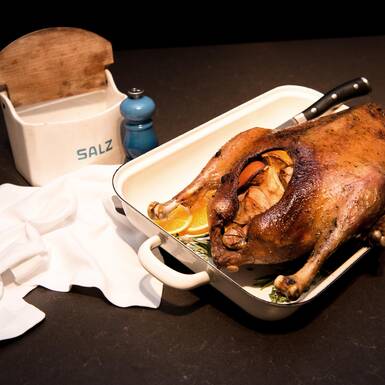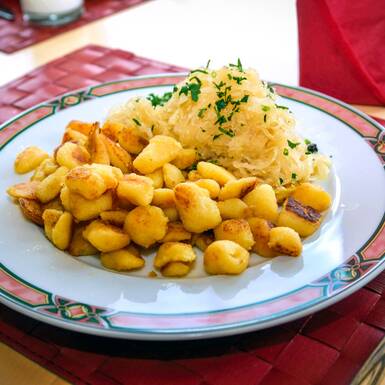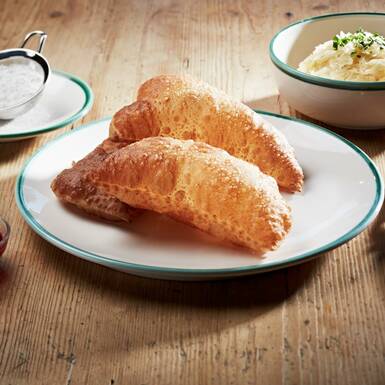- Cuisine
Kathi’s Christmas fruit loaf
When the freshly baked fruit loaves begin to slowly emerge from the kitchen ovens in Saalbach Hinterglemm during the Advent period, the house is quickly filled with Christmas scents triggering childhood memories. The fruit loaf (“Kletzenbrot”) is a real Christmas classic in the Pinzgau region. Kathi Wimreiter from Hinterglemm tells “Saalbach Stories” about her inherited family recipe.
When cutting into the loaf, the crunchy crust first produces a soft crack, as the juicy and soft filling made from dried pears (known as “Kletzen” in Pinzgau), raisins and nuts, exudes a fruity aroma. It’s a sweet tasting bread, which, thanks to its sweet pears, does not require any extra sugar and is best enjoyed with a thick spread of butter. Even though there are many regional variations – some places add additional figs, candied orange peels or dates – one thing always remains the same: the Pavlovian effect! Because you simply can’t help but be immediately reminded of Christmas trees, candle lights and presents when taking your first bite.
Kathi’s family recipe
During summer, Katharina Wimreiter works at the Bärenwirt tavern in Fusch at Glocknerstrasse, during winter she looks after the Wimreiter Apartment at the Hochalm valley station. She can still remember the days when her grandmother baked the fruit loaf. “It was always something very special – even though we had to save on the filling as the ingredients were quite expensive back in the day. The pears came from our own garden and we dried them ourselves. Instead of pricy raisins, my grandmother looked for the more affordable “Zibeben” variety. Baking took place at home in our yard in the smokehouse. Of course, we first removed the bacon from the smokehouse in order to prevent the fruit loaf from tasting like it. I can remember exactly how, when we were children, we used to sit on the floor of the old kitchen while pushing the loaves into the ember of the smokehouse with long rods. The whole house started to smell of it and everyone got excited. However, the finished loaves were carefully hidden by my grandmother, so that we wouldn’t eat them all up before Christmas,” laughs Katharina Wimreiter while remembering her childhood.
Kathi’s fruit loaf recipe
The busy tavern owner continues to use her grandmother’s recipe and her yearly 54 fruit loaves have already been baked. She explains, “It’s a long tradition, I make 54 fruit loaves for all godchildren, friends and family members before the Advent period. The fruit loaves can be stored for a long time. If the crust gets hard after a while, all you have to do is wrap the loaf in a moist towel.
Recipe
6 loaves, 1kg each
Ingredients:
For the rye dough:
- 1.7kg rye flour
- 10g salt
- 4 packs of dry yeast
- approx. 1 1/8 litre of lukewarm water
For the filling:
- 1.7kg raisins
- 600g dried pears
- 200g whole hazelnuts
- 5g ground cloves
- 20g ground cinnamon
- 1/8 litre rum
- ¼ litre water
Preparation:
For the dough, mix the flour, salt and yeast together with lukewarm water in a mixing machine for approximately 10 minutes until you have a malleable dough. Then, pour a bit of flour over the dough, cover it with a cloth and put it somewhere warm to rise for two hours. Knead it occasionally. The filling is prepared right after the dough. Soak the raisins, nuts, dried pears (you can get these at the local supermarkets), clove and cinnamon powder in rum and water. Let the mixture rest for two hours and stir it every once in a while so that the dried fruits can evenly soak up all the water and rum.
The “Bladl” is a bread cover that prevents the raisins from burning and getting bitter. For this, you take 6 fistfuls of dough and roll it out on a floured surface and then put it aside. If the dough is too soft to be rolled, just add some flour to it. The remainder of the dough is separated into 6 equally sized parts. Take two fistfuls of the now soaked fruit filling, press it into one of the six dough parts and knead it well. Take the filling infused dough and form it into a loaf and cut right through the middle. In the case of too little fruit in the filling, add a little more to it and form the dough into a new loaf.
In the meantime, heat the oven to 150 degrees. Place the loaves on the “Bladl” and position it well. Press the Bladl together. The lower side of the loaf does not need to be fully covered. Now, place the loaf on a greased baking tray. Coat it with water and poke into it with a fork to keep the crust from tearing. Give the loaf a little knock when taking it out of the oven after approximately 1 hour at 150 degrees. If it sounds hollow, it’s done.












